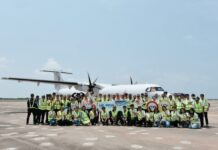

Can you remember a time when the constant, steady roar of aircraft overhead was so normal that you didn’t look up? Did you ever imagine a time, like now, when that very same noise was a rare occurrence, causing you to gaze skywards, wondering when air travel might return?
Believe it or not, the skies above us are much busier than you might think. 100,000 air cargo flights each and every day are travelling through air corridors, transporting $18.6bn worth of goods, keep the global supply chain running. This is what air cargo has always done and continues to do with an even greater effect in the pandemic, when the first and last mile become even more important.
The absolutely critical need to get COVID vaccines to the world’s population, has led to air cargo operators needing to optimise their operational and logistical performance to the max. When it comes to the fight against COVID, getting cargo to the correct destination in the least possible time at the lowest cost, is key to winning the battle. But our story doesn’t start today. The solution to optimised cargo transportation began more than ten years ago in the warehouses and offices of cargo operators. Franziska Burmester was then a young analyst, part of an international aviation consultancy, and deeply frustrated at the waste within the industry she loved and still loves.
Franziska could only watch as overtime and shift changes sore as employee satisfaction and attrition became an increasing issue. But it wasn’t the planners who were at fault, delayed in-bound flights and trucks, limited planning transparency, rigid union agreements, sickness amongst staff and other unexpected events all contributed to the chaos and cost. There had to be a better way.
Lana Jansen also worked in the aviation industry, with a passion for aircraft and aviation. Lana spent much of her time leading large projects for airlines and airports. She too saw the waste created by lack of transparency and automation, last minute changes and the inability of the planners to cope – the equation was simple: you have quality, time and cost. If you change the time available, then either the quality goes down or the cost goes up. Watching the profits being eaten away by increasing labour costs, Lana was left with the same feeling; ‘there had to be a better way’.
The two women ended up working for the same company and maybe it was by the water cooler, or maybe by the coffee machine, but one day they got together to swap war-stories and in doing so the kernel of an idea hit them, which has since become WePlan.
Franziska explains: “We decided to use our experience in resource planning to develop a solution that truly solves the problems that planning teams face on a daily basis, enabling them to get transparency on actual cost of service and then make cost-optimal decisions. In times of growing complexity, we wanted to create a tool that simplifies the planning process and optimally supports the planner.”


WePlan, so you don’t have to
The name of this tool? WePlan, and the ‘we’ is an important factor.
• WePlan is a manpower planning tool that makes creating resource plans and scenarios for even the most complex operational environments simple, flexible and time-efficient.
• It eradicates the need for the arduous task of inputting large amounts of data into spreadsheets. In fact, spreadsheets are not needed at all!
• Everything is done within the WePlan tool, meaning that all relevant data can be added to one space. This is where the ‘we’ comes into play. Take a cargo airline for instance. The training team will need to estimate the pilot training hours needed, while HR will total up pilot and crew leave. This all needs to be factored into the resource plan to ensure the manpower prediction adequately covers the flying schedule. WePlan allows all input to happen in one space online.
• Flexible planning takes the complexity out of operational planning, as Lana explains: “WePlan enables smart, intuitive and flexible manpower planning for both long and short-term. The innovative technology that we have applied to WePlan means that analysing, forecasting, and comparing different scenarios can be achieved in seconds. The planner can even input old plans and look at how they matched up to the actual roster data, highlight where efficiencies can be made for future plans.”
• Accurate resource planning and activity based costing, “This is at the core of WePlan”, recaps Franziska.
Who has welcomed WePlan onboard?
The WePlan team is working with both carriers and handlers, along with others in the world of air cargo. WePlan is the perfect match for cargo roster volatility WePlan’s estimator feature lets planners input information such as flight schedules, tonnages, planning rules, process times and a wide variety of further information into the tool to estimate the exact workforce demand within seconds. This is particularly valuable for airlines and handlers with volatile schedules, such as in cargo.
What’s next for Lana and Franziska?
“2021 is all about making maximum impact. These are the most turbulent of times, and seeing WePlan cut through that, bringing operational and cost efficiency as well as transparency to our customers makes us (and them) very happy. So for now our focus is on introducing more and more people to WePlan and its benefits.”
To find out more about WePlan visit www.weplan.info and follow WePlan on LinkedIn https://www.linkedin.com/company/weplan-software/










